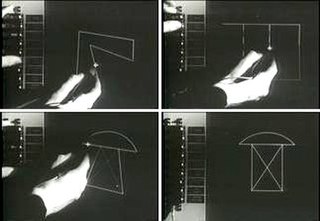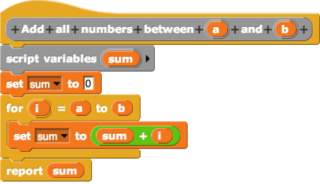The graphical user interface is a form of user interface that allows users to interact with electronic devices through graphical icons and audio indicator such as primary notation, instead of text-based user interfaces, typed command labels or text navigation. GUIs were introduced in reaction to the perceived steep learning curve of command-line interfaces (CLIs), which require commands to be typed on a computer keyboard.

In the industrial design field of human–computer interaction, a user interface (UI) is the space where interactions between humans and machines occur. The goal of this interaction is to allow effective operation and control of the machine from the human end, while the machine simultaneously feeds back information that aids the operators' decision-making process. Examples of this broad concept of user interfaces include the interactive aspects of computer operating systems, hand tools, heavy machinery operator controls, and process controls. The design considerations applicable when creating user interfaces are related to, or involve such disciplines as, ergonomics and psychology.

Sketchpad is a computer program written by Ivan Sutherland in 1963 in the course of his PhD thesis, for which he received the Turing Award in 1988, and the Kyoto Prize in 2012. It pioneered human–computer interaction (HCI), and is considered the ancestor of modern computer-aided design (CAD) programs as well as a major breakthrough in the development of computer graphics in general. For example, the graphical user interface (GUI) was derived from Sketchpad as well as modern object-oriented programming. Using the program, Ivan Sutherland showed that computer graphics could be used for both artistic and technical purposes in addition to demonstrating a novel method of human–computer interaction.
The Aspen Movie Map was a revolutionary hypermedia system developed at MIT by a team working with Andrew Lippman in 1978 with funding from ARPA.

In computing, a visual programming language is any programming language that lets users create programs by manipulating program elements graphically rather than by specifying them textually. A VPL allows programming with visual expressions, spatial arrangements of text and graphic symbols, used either as elements of syntax or secondary notation. For example, many VPLs are based on the idea of "boxes and arrows", where boxes or other screen objects are treated as entities, connected by arrows, lines or arcs which represent relations.
Interaction design, often abbreviated as IxD, is "the practice of designing interactive digital products, environments, systems, and services." Beyond the digital aspect, interaction design is also useful when creating physical (non-digital) products, exploring how a user might interact with it. Common topics of interaction design include design, human–computer interaction, and software development. While interaction design has an interest in form, its main area of focus rests on behavior. Rather than analyzing how things are, interaction design synthesizes and imagines things as they could be. This element of interaction design is what characterizes IxD as a design field as opposed to a science or engineering field.

Across the many fields concerned with interactivity, including information science, computer science, human-computer interaction, communication, and industrial design, there is little agreement over the meaning of the term "interactivity", but most definitions are related to interaction between users and computers and other machines through a user interface. Interactivity can however also refer to interaction between people. It nevertheless usually refers to interaction between people and computers – and sometimes to interaction between computers – through software, hardware, and networks.
A2 is a modular, object-oriented operating system, with some unconventional features, including automatic garbage-collected memory management, and a zooming user interface. It was developed originally at ETH Zurich in 2002. It is free and open-source software under a BSD-like license.
Multimodal interaction provides the user with multiple modes of interacting with a system. A multimodal interface provides several distinct tools for input and output of data.
User interface modeling is a development technique used by computer application programmers. Today's user interfaces (UIs) are complex software components, which play an essential role in the usability of an application. The development of UIs requires therefore, not only guidelines and best practice reports, but also a development process including the elaboration of visual models and a standardized notation for this visualization.

Presentation–abstraction–control (PAC) is a software architectural pattern. It is an interaction-oriented software architecture, and is somewhat similar to model–view–controller (MVC) in that it separates an interactive system into three types of components responsible for specific aspects of the application's functionality. The abstraction component retrieves and processes the data, the presentation component formats the visual and audio presentation of data, and the control component handles things such as the flow of control and communication between the other two components.
Naked objects is an architectural pattern used in software engineering. It is defined by three principles:
In computing, an object-oriented user interface (OOUI) is a type of user interface based on an object-oriented programming metaphor. In an OOUI, the user interacts explicitly with objects that represent entities in the domain that the application is concerned with. Many vector drawing applications, for example, have an OOUI – the objects being lines, circles and canvases. The user may explicitly select an object, alter its properties, or invoke other actions upon it. If a business application has any OOUI, the user may be selecting and/or invoking actions on objects representing entities in the business domain such as customers, products or orders.
Paulo Pinheiro is a Brazilian American computer scientist working in the areas of provenance and semantic web in support of sciences. Pinheiro has been a research scientist at the Rensselaer Polytechnic Institute's Tetherless World Constellation since 2013. Between 2011 and 2013, he was a staff scientist at the U.S. Department of Energy's Pacific Northwest National Laboratory. Between 2006 and 2012, he was an associate professor of computer science at the University of Texas at El Paso. Pinheiro is from a long line of scientists and engineers: his father is a retired professor of material sciences at the Universidade Federal de Minas Gerais; his paternal grandfather was the founding Mine Superintendent of Vale S.A., the second largest mining company in the world and Israel Pinheiro da Silva, a great-grand-uncle, was the chief engineer responsible for the construction of Brasilia, the capital of Brazil.
Fabio Paternò is Research Director and Head of the Laboratory on Human Interfaces in Information Systems at Istituto di Scienza e Tecnologie dell'Informazione, Consiglio Nazionale delle Ricerche in Pisa, Italy.
SIGNAL is a programming language based on synchronized data-flow : a process is a set of equations on elementary flows describing both data and control.
ConcurTaskTrees (CTT) is a notation for task model specifications useful to support design of interactive applications specifically tailored for user interface model-based design.

Parametric design is a design method where features are shaped according to algorithmic processes, in contrast to being designed directly. In this method, parameters and rules determine the relationship between design intent and design response. The term parametric refers to input parameters fed into the algorithms.
Joëlle Coutaz is a French computer scientist, specializing in human-computer interaction (HCI). Her career includes research in the fields of operating systems and HCI, as well as being a professor at the University of Grenoble. Coutaz is considered a pioneer in HCI in France, and in 2007, she was awarded membership to SIGCHI. She was also involved in organizing CHI conferences and was a member on the editorial board of ACM Transactions on Computer-Human Interaction. She has authored over 130 publications, including two books, in the domain of human-computer interaction.
Wisdom is a software development process and method to design software-intensive interactive systems. It is based on object modelling, and focuses human-computer interaction (HCI) in order to model the software architecture of the system i.e. it is architecture-centric. The focus on HCI while being architecture-centric places Wisdom as a pioneer method within human-centered software engineering. Wisdom was conceived by Nuno Nunes and first published in the years 1999-2000 in order to close the gaps of existing software engineering methods regarding the user interface design.





